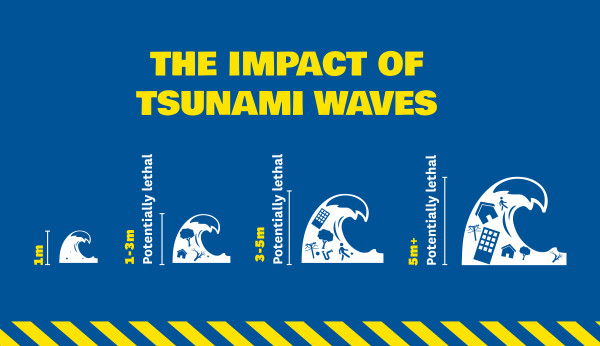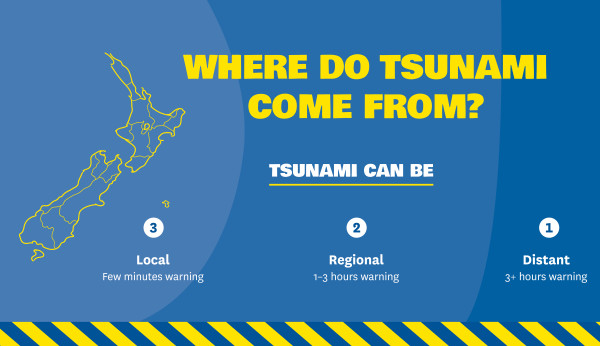Tsunami
This page provides messages about tsunami.
In this section:
- Reduction: Reduce the impacts of tsunami
- Readiness: Get prepared to respond to a tsunami
- Response: What to do during a tsunami
- Recovery: What to do after a tsunami
- New Zealand’s entire coastline is exposed to tsunami hazard. Tsunami can also happen in larger lakes. Tsunami can violently flood our shores, causing devastating property damage, injuries and loss of life.
- In New Zealand, some of the biggest tsunami are caused by events close to our shore, and can arrive within minutes.
- For a local-source tsunami which can arrive in minutes, there is not enough time for an official warning. It is important to recognise the natural warning signs and act quickly.
- Remember, Long or Strong, Get Gone: If you are near the coast and experience any of the following:
- Feel a strong earthquake that makes it hard to stand up, or a weak rolling earthquake that lasts a minute or more.
- See a sudden rise or fall in water level.
- Hear loud and unusual noises from the water.
- Move immediately to the nearest high ground or as far inland as you can, out of tsunami evacuation zones. Do not wait for official warnings.
- Walk, run or cycle, if you can. This reduces the chances of getting stuck due to damaged roads or traffic congestion.
- Your local Civil Defence Emergency Management Group has tsunami evacuation zone maps and local advice. Make sure you know where to go, whether you are at home, at mahi/work or out and about.
- Plan evacuation routes from your whare/home, farm, kura/school, wāhi mahi/workplace, or any other place you frequently go, that is in a tsunami evacuation zone.
- Once you have evacuated, follow official advice from your local Civil Defence Emergency Management Group about when it is safe to return to tsunami evacuation zones. Do not return until an official all-clear message is given by Civil Defence Emergency Management. Tsunami activity will continue for several hours and the first wave may not be the largest.
A tsunami is a series of powerful waves with strong currents. They are mostly caused by underwater or coastal earthquakes, and sometimes by underwater landslides or volcanic eruptions.
Tsunami waves have a lot of power and travel much further and faster inland or up hills than regular waves. Once they travel over land, tsunami waves can keep going at the speed of a car on land (30km per hour), so you can’t out-run them. They can damage or destroy buildings and lifeline utilities and carry vehicles and boats. Tsunami waves pick up things in their path like trees, vehicles or bits of buildings which can cause further damage as they are moved by the wave. The largest wave may happen several hours after the first wave and there can be more than one set of waves.

New Zealand’s entire coastline and some of our larger lakes are exposed to tsunami hazard. Tsunami can violently flood our shores, causing devastating property and lifeline utility damage, injuries and loss of life.
In New Zealand, some of the biggest tsunami are caused by events close to our shore, and can arrive within minutes.
Tsunami can come from different sources.
Local-source tsunami can arrive at New Zealand coastal areas within minutes. They are generated very close to New Zealand, usually by earthquakes. This type of tsunami is very dangerous because of their short arrival times.
Regional-source tsunami are between one and three hours travel time away from New Zealand. A large earthquake in the Southwest Pacific, and an eruption from an underwater volcano in the Kermadec Trench to the north of New Zealand, are two possible triggers for regional tsunami.
Distant-source tsunami take at least 3 hours and in some cases 14 hours or more to arrive. A distant-source tsunami is most likely to be generated by a very large earthquake in the Pacific Ocean, particularly off the South American coast.
For a local-source tsunami, which can arrive in minutes, there is not enough time for an official warning. It is important to recognise the natural warning signs and act quickly.
For regional or distant-source tsunami, there is time to issue official tsunami warnings.

Lake tsunami
Tsunami can happen at inland locations in lakes and other large bodies of water – not only on the coast.
Lake tsunami can be caused by earthquakes, landslides (starting above the lake or underwater), rock falls, volcanic eruptions, dam failures and glacier collapses.
Even a small earthquake could trigger a large landslide at a mountain lake or fiord/sound that generates a tsunami. In these cases, natural warning signs may be weak or unnoticeable.
It is important to recognise the natural warning signs and act quickly.
